CAC History,
1913 to Present:
Verna Steele West’s “CAC Early History” Essay
The California Alpine Club has a long and colorful history.
In 1913 a small group of hikers from a Bay Area YMCA encouraged others to join them for Sunday morning hikes on Mt. Tamalpais. By ferry, from San Francisco or Oakland, to Sausalito, the hikers then boarded a train to Mill Valley. By 1914, the regulars named themselves the California Alpine Club (CAC) and counted 84 dues-paying members.
Early CAC members helped build the Mountain Theater atop Mt. Tamalpais, and placed the first Hikers Registers at the pinnacle of Mt. Whitney, Mt. Shasta, Lassen Peak, Mt. Tallac, and Mt. St. Helena, and many other peaks in the Sierra Nevada and Klamath mountains.
By 1936, the Mt. Tam building had been added to the Alpine Lodge property and CAC was incorporated as a State of California 501(c)(7) non-profit social club. The Echo Summit Lodge property was purchased in 1952 and Club outings had expanded to include excursions across many other U.S. states, and international trips, run by CAC members.
Today, our horizons continue to expand, and our California Alpine Club Foundation, a State of California 501(c)(3) founded in 2004, gives grants to further local outdoor recreation and environmental conservation efforts.
EARLY CALIFORNIA ALPINE
CLUB HISTORY
by Verna Steele West
March 12, 2012
Overview
The California Alpine Club, established in 1913, is a non-profit corporation with an elected Board of Directors and various appointed Committee Chairs. It was incorporated on April 5, 1936, with legal help from early member Hilary Crawford, Sr. The Board of Directors handles Club business, social affairs, publishes the newsletter TRAILS, maintains the Club website, establishes dues, and reviews recommendations from the California Alpine Club (CAC) Lodge Trustees, as well as generally seeking to maintain a diversity of activities, hospitality, and camaraderie of the membership,
We have a long history, and are fortunate to possess an archive of Club activities, including meeting minutes from April 16,1914 to the present day. From the beginning, the Club has depended on the many men and women who have volunteered their skills, time, and resources for the benefit of the membership.
The California Alpine Club owns two lodges: Alpine Lodge on Mt. Tamalpais, purchased in 1925; and Echo Summit Lodge overlooking Lake Tahoe, purchased in July 1952. The lodges are independently managed; each by their own elected Board of Trustees who reports to the CAC Board of Directors.
The Beginning
In February and March 1913, the San Francisco “Call Bulletin” published a series of articles on outdoor recreation. Upon invitation of the writer, a few people, including the San Francisco YMCA Hiking Group, began to meet on Sunday mornings for hikes in the Bay Area. In April, a club was formed under the name of the newspaper. Officers were elected, a constitution adopted, and arrangements made for the printing of a schedule of weekly trips.
Most came from San Francisco or Oakland by ferry to Sausalito, then by train to Mill Valley for the hikes on Mt. Tamalpais or on to Stinson Beach (Willow Camp). At a “Hikers’ Retreat” in Mill Valley, lockers could be rented and showers were available. Until 1930, the Mt. Tamalpais and Muir Woods Railway, built in 1896 and affectionately called “The Crookedest Railroad in the World,” took passengers from Mill Valley to the top of Mt. Tamalpais. One member wrote of hiking up as far as West Point Inn, then riding the “Gravity Cars” back down 8.25 miles, around 281 turns on the mountain’s 7% grade to the Mill Valley or Muir Woods depot, after winding around the Double Bow Knot.
On April 16, 1914, at a special evening meeting in Polito Hall in San Francisco, with President Frank Allen presiding, by-laws were considered and adopted for the newly named CALIFORNIA ALPINE CLUB. Officers were confirmed; elected were Frank Allen, W. Evans, H. A. Funk, Miss J. Higgins, and H. Albert. All connections with the newspaper organization were severed.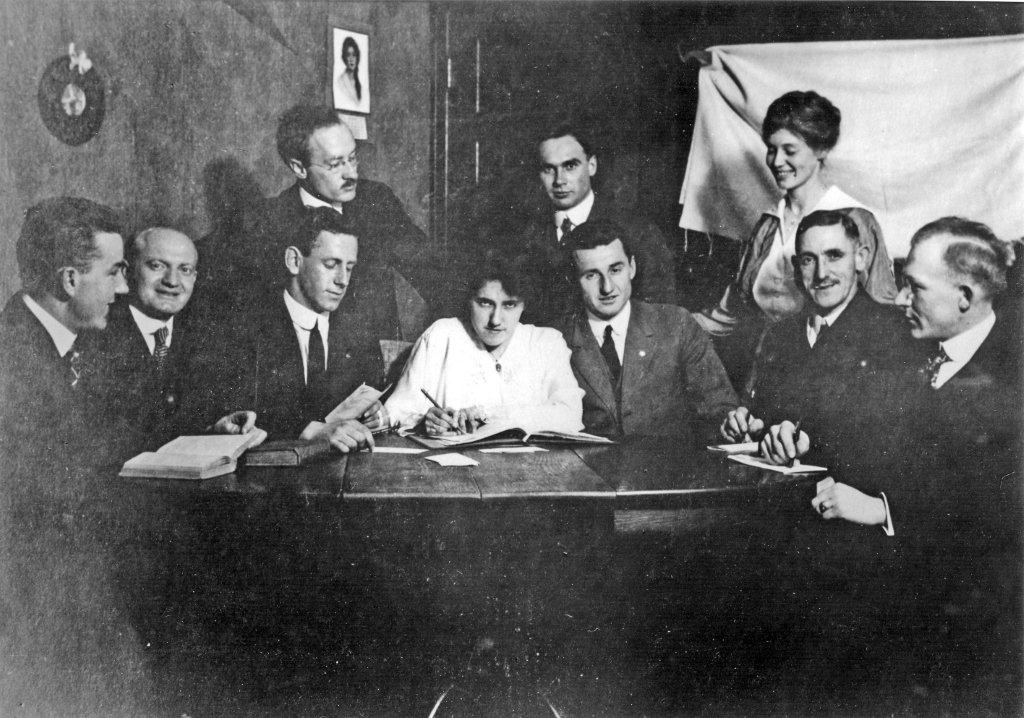
Note: In 1913, M. H. de Young, owner of the “San Francisco Chronicle,” purchased the “Call Bulletin,” then sold it to William Randolph Hearst. The Bulletin changed names many times before 1965 when it finally became “The San Francisco Examiner”.
Subsequent meetings were scheduled for the first Sunday of every month at the hike lunch destination. Names of prospective members were read and considered at each meeting. Forty-three new members joined the CAC during the year. Many decisions were made. On June 7, 1914, at Rodeo Lagoon in Marin County, the Club adopted the “Arrowhead” emblem, which is still used today, and ordered the 2’x 6′ pennant that is seen in many early photographs.
A Schedule of Walks was printed twice a year, November and April. Quarterly meetings were held in April, July, October, and January. On October 4, 1914, it was moved, seconded, and carried “to eliminate any religious ideas whatsoever from front piece of new Schedule of local walks.” Also decided was that walks would be held every month of the year. On November 8, 1914, at McNears Point near San Rafael, it was moved, seconded, and carried that: “No member of the Club can take any active part or voice at meetings of the Club unless his or her dues to the Club for the current year are paid and a receipt held by him or her from the Secretary.”
In 1914, eighty-four people who might be considered “founding members” paid annual dues. No list of Charter Members (if one existed), or records prior to April 1914 have been found.
At the Annual Meeting on April 4, 1915, held at California City Club in San Francisco, five new officers were elected: Al Pinther, President; Aaron Stoff, Vice President; Bill Harris, Treasurer; Alice Casazus (Griffith), Secretary; and Mike Murphy, Corresponding Secretary. None of the 1914 officers were re-elected.
On September 13, 1915, at a “special” evening meeting, a new constitution and by-laws were adopted. The objective of the Club: “To make excursions into trailed and un-trailed portions of California for the purpose of bringing the people of the cities out in the open, and the full enjoyment of the natural wonders of the State; to aid in every way possible, the preservation of woods, streams, game, and natural features of the country”.
On November 7, 1915, another evening special meeting was held at Polito Hall (rented for $4.50) in San Francisco, to add additional members to the Board of Directors as required by the new constitution. There were five elected from fifteen nominees: Harry Phillip West, John Leggett, Oscar Cook, Beth Stripling, and Harry Funk. Al Pinther presided over this first Board of eight men and two women. A photograph of this “First Board of Directors” hangs on the wall in Hertenstein Hall, Alpine Lodge on Mt. Tamalpais.
Afar and On Top
Al and Norma Holroyd Pinther were lifetime members and supporters of the California Alpine Club and The Mountain Play on Mt. Tamalpais, which was founded in 1912. Many members took part in these productions year after year. Member William Kent deeded the land that is now the Mountain Theater in 1915, and in May, the Club formally endorsed The Mountain Play.
Art Blake, with members of the Tamalpais Conservation Club and many other CAC members, aka “Alpiners,” worked with the CCC (Civilian Conservation Corps) to spend the summer building this outdoor amphitheater that would seat 4,000 people. Art even built a small cabin on site and lived there. In 1921, fifty-seven CAC members participated in The Mountain Play’s production “Tamalpa.” A list of the first ten plays appears in the 1922 annual issue of TRAILS. The Mountain Play has grown with the California Alpine Club and the connection between the two remains strong.
On July 16, 1916, CAC Club members climbed 14,502-foot-tall Mount Whitney and placed the Hikers Register on top.
The first “Annual Outing” to the Sierra was in July 1919. Thirty-seven members went by train to Porterville, California, by truck to the Tule River, then hiked nine miles to a pack station at Camp Nelson. Here, they joined twenty pack mules for two weeks in the Kern Canyon area. Thirty-two members signed the Hikers Register at the top of Mt. Whitney, which had been placed there by CAC members three years earlier. By 1923, at least eighteen more mountains were climbed and registers placed by CAC members.
An excerpt from a TRAILS newsletter in 1920 reads: “The enthusiasm of those participating caused the Board of Directors to submit an amendment to the bylaws creating an ANNUAL OUTINGS COMMITTEE.” For the July 1920 Kings Canyon outing, the committee was responsible for engaging the pack train, employing a chef and assistants, and purchasing and shipping all supplies and equipment to and from the campsite. The outings were to be run “at cost” to make it possible for many to travel in “Big Country” with much greater comfort and convenience than if by individual excursions.
World War I
Seventy-four of 206 California Alpine Club members served in the military during World War I, 1916-1918; including, Alice Casazus (Griffith), a telephone operator, two women Yeomanettes, and two women Marinettes. Anita Franz (West) and Norma Holroyd (Pinther) worked for the government in Washington D.C.
At almost every Club meeting one or more of the “boys” resigned from a Club office or committee because of having been called to service. A “Service” flag was created with a star added for each member serving. The Club voted to suspend dues for anyone who left for the front.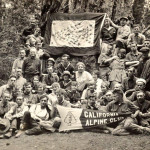
A “Sweet Box” committee, chaired by Beth Stripling, was established, and all the addresses for those serving were obtained. The girls met once a week at homes on both sides of the Bay, writing letters, and contributing 10-12 boxes of home made goodies per meeting. Beth picked up, sorted, and mailed everything. At Christmas, every member in service received a gift from the California Alpine Club. To this day, the committee, later re-named the “Sunshine Committee,” continues to graciously recognize and support members in times of hardship.
CAC Comes of Age
Bill, Chris, and Archie Halliday’s stationery store at 2506 Mission Street, San Francisco, served as the Club’s first office and information center. In 1923, it was moved to Bill and Marie Halliday’s gift shop at 37 Powell Street. The Club eventually shared space with the Tamalpais Conservation Club at 525 Pacific, moving to the Flood Building in 1978. CAC records and archives were moved to the Alpine Lodge in 1987, and are now stored in the Tam Building. Bill Halliday’s name remained as one of the three “owners and trustees” of Alpine Lodge until his death from a heart attack suffered on a CAC High Trip to the Sierra in 1952, at which time, titles to the adjoining properties and the Alpine Lodge were transferred to the California Alpine Club.
A Ski Trip in February 1916 to Truckee via Donner Pass by overnight train was very successful, as were trips to the Pinnacles, Mt. Hamilton, La Honda, Pescadero, and to Forest Lodge. Joint events were scheduled with the Contra Costa Hills Club, Sierra Club, and other outdoors organizations.
By the 1920s membership had grown to 252.
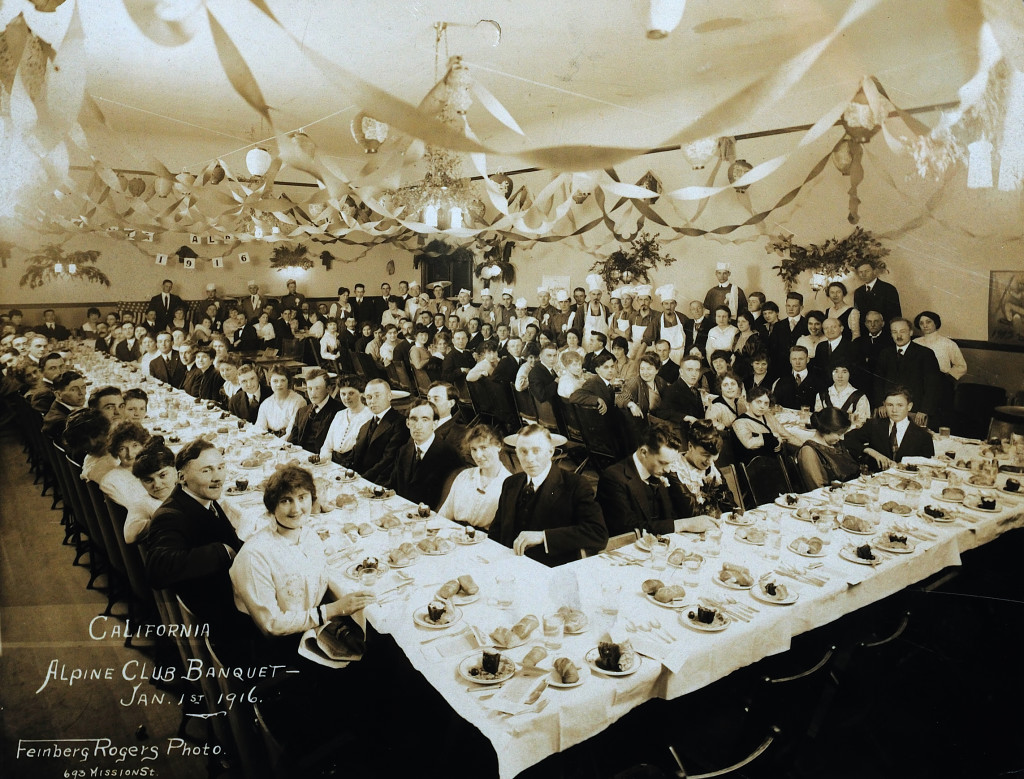
The Initiation fee was $2.00, as were annual dues. Attendance at Club affairs was very high, from sixty to a hundred people on most occasions. There are photos of large groups hiking together.
Men helped clear roads and made new trails. Bay Area walks or social events were scheduled nearly every weekend, interspersed with longer trips further afield. More than 300 people attended the “New Year’s Jinks” at Kentfield Stadium on January 11, 1920. Friends and relatives were invited to Annual Reunion events. In June 1920, 500 guests attended. Occasional “moonlight” walks helped the Club be referred to by some as “the California Alpine Matrimonial Club.” More than 600 visitors registered for the Club’s “Camp Craft” show in 1921.
Very beautiful volumes of the Club’s newsletter TRAILS were published from 1920-23. They included detailed stories about outings, supported by fine photographs, poems, lists of members, financial statements, and schedules of walks. Of particular interest were the business advertisements of members. Porter Griffith contributed cartoons and designed the cover ad for the West-Franklin-Pinther “Forest Lodge” in Greenville, Plumas County, California that served as a mountain get-away for members from 1917 into the 1940s, before Echo Summit Lodge was purchased.
Alpine Lodge on Mt. Tamalpais
In the early 1920s, members began thinking of finding a permanent home for the Club on Mt. Tamalpais, and held a variety of fund-raising events: parties, dinners, and dances. Harry Hertenstein found the stone-walled “cabin” on Throckmorton Ridge, with views of both ocean and bay, which was for sale.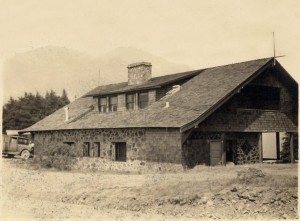
In a letter dated February 23, 1983, Jules Sigrist recalls meeting with Harry Hertenstein in 1925 as he came out of a Club meeting while discussing the purchase of the cabin. Not enough money had been raised. The two of them went up to see the cabin, and Jules decided to loan the needed $1,700. Jules Sigrist named Harry Hertenstein, Tim Murphy (Club President), and Bill Halliday (past President) as Trustees and Owners of the property. The following year, Al Pinther’s name replaced Tim Murphy on the ownership records. Other records indicate the cabin was purchased from Mr. Turner, a U.C. Professor whose new bride was not enamored with his mountain retreat. The same letter also mentions Vic Hahn and William Fankhauser as deserving much credit for the early success of Alpine Lodge on Mt. Tam.
With almost all volunteer help, the Club gradually added to the stone cabin a second-floor women’s dormitory, surrounding porch, professional kitchen, septic tank, showers, and purchased adjoining properties for a men’s dormitory called the Tam Building. Oscar Cook had a plumbing business; Clyde Williams, electric appliances; Sam Deal sold insurance; Hilary Crawford, Sr. provided legal advice. All contributed greatly to the development of CAC’s Alpine Lodge property.
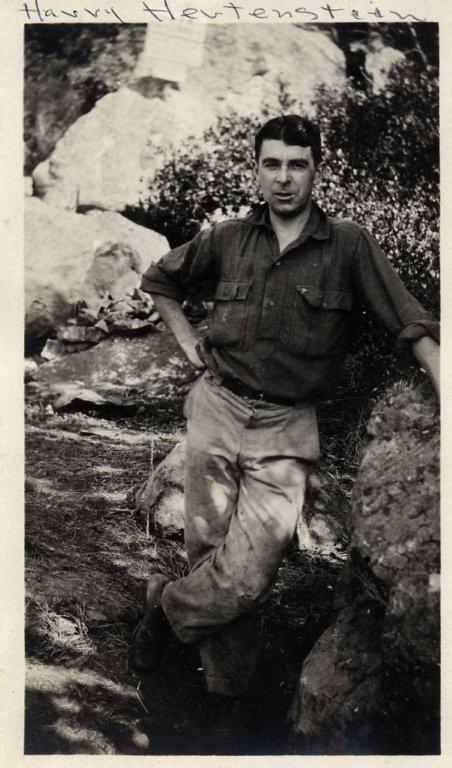
Harry Hertenstein, who joined the Call Bulletin Club in 1913, was an architect with a shop on Florida Street in San Francisco, where much of Alpine Lodge pre-construction remodeling plans took place over the years. His shop also became the storage place for all Club camp equipment and supplies. Harry and Alma, his wife, were life-long supporters of the California Alpine Club. In 1952-54 he designed and helped build Hertenstein Hall. He was also one of the first Trustees of Echo Summit Lodge from 1952-56.
CAC was an early member of the Federation of Western Outdoor Clubs (FWOC). Many FWOC member clubs donated “stones” for the large fireplace in the recreation hall named after Harry.
Over the years there have been many alterations and additions to Alpine Lodge. The large “Hertenstein Hall” was added and finished in 1954. The large east-facing deck was added in 1995 after the dining porch was enlarged. There have been other updates and modernizations over the years: a uni-sex bathroom on the main floor, a large bathroom on the second floor, kitchen updates, and a lot of attention paid to décor, comfort, and the garden and grounds. Numerous changes and updates to the Tam Building resulted in five separate bedrooms as well as a men’s dorm.
A major expense was to install a complete new biodynamic sewer system for the lodge and Tam Building in 2003, partially covered by a “special assessment” fee paid by all members. On March 26, 2004, a new fire sprinkler system in the upstairs bathroom of Alpine Lodge went off unnoticed for several days and completely flooded the floors upstairs, downstairs, and into the basement. The damage done led to a refurbishment of all the old floors, ceilings, and kitchen. Hertenstein Hall floors were also refinished in January 2005.
Today, Alpine Lodge is the site of most official Club functions and social gatherings. Every Sunday, CAC Innkeepers welcome the general public offering coffee, snacks, and an introduction to the Club. Scheduled member hikes begin and end at this historic Lodge.
Echo Summit Lodge, Lake Tahoe
In the late 1940s, a search for a Sierra Nevada mountain lodge was proposed, mostly supported by the “Youth” group in the Club. Many older members supported the younger members’ wish to obtain a ski lodge: Charles and Esther Andresen Blake, Sam and Tense Sullivan Deal, Harry and Alma Schirmer Hertenstein, Al and Norma Holroyd Pinther, Al and Evelyn Reese Tunzi, Harry P. and Anita Franz West, and Casper and Anna Zwierlein. It was an issue that was debated with much fervor, and almost split the Club in two.
With more than 460 members in 1951, the CAC by-laws were amended (with a lot of opposition) to allow the acquisition of a mountain lodge. The “Youth” group of the Club, chaired by Hilary Crawford, Jr., raised money and the search for a ski lodge was on. Gladys Peyser first suggested the scenic area off Highway 50 overlooking Lake Tahoe. Jean Miller, Ken Wiltz, Hilary, and others skied in and found a place for sale in 1951. A larger group came during the summer, including Dr. Budd Smith, Gail Lindlow, Verna Steele, and Harry West. Some of the “old-time” members also inspected the place and the decision was made to purchase Echo Summit Lodge from the owners, Mr. and Mrs. Butler, for $10,000. Al Pinther loaned $5000 to the Club, and with money already raised, the building was purchased in July 1952.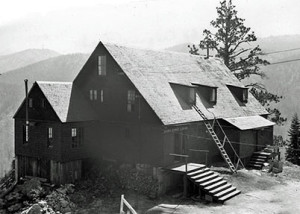
The lodge consisted of a small grocery store, dining room, bar, and kitchen on the first floor; nine bedrooms and two bathrooms on the second with a ladder out the window for a fire escape; and an unfinished attic–all heated by two wood-burning stoves on the first floor. The lodge and several smaller buildings sat on land in the Public Domain, consequently the Club inherited a renewable Use Permit administered by the U.S. Forest Service.
CAC member volunteers completely remodeled the lodge with a new kitchen, a women’s dorm on the third floor, a men’s dorm and bathroom with a shower replacing the bar, a barbeque deck off the communal dining room, and stairway exits at both ends of the structure from all three levels. The septic system was upgraded with a new stainless steel tank and bio filter in 2005.
Dr. Budd Smith was the first Echo Summit Lodge Trustee Chairman, holding office for twenty-seven years. Harry Walter West was also one of the first five ESL Trustees and served for thirty-five years; succeeded by his daughter Judy West (the first female trustee), for another fifteen years. ESL Trustee Ray Sommer served 31 years from 1982 to 2013.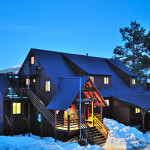
Echo Summit Lodge Trustees, concerned with terms of the Use Permit that prohibit discrimination against the handicapped, began talks with the Forest Service in 2007. From 2009-2011, the Trustees managed construction and modification of building entryways, ramps, and parking lot upgrades to comply with the federal Americans With Disabilities Act (ADA) standards. As a result of these and numerous other improvements to building exteriors and water systems, the U.S. Forest Service renewed the Club’s Use Permit in 2011 for another ten-year term.
California Alpine Club Archives
As of 2012 there have been seventy-five California Alpine Club Presidents, most serving one-year terms. Sixteen presidents served for two years, and Ray Sommer 1961-63, Robert Mugg 1973-1975, and Laurence Kornfield 2001-03 served for three. Officers and Board of Directors are elected for one-year terms. (As of 2014 the term will be two years.— ED) Lodge Trustees serve three-year terms. (As of 2014, current president Jim Nixon is serving a fourth term.– ED)
Photographs of all Presidents except one are kept in a small album in the Alpine Lodge living room. Minutes from April 16, 1914, and many other records are stored in the Tam Building. All the TRAILS newsletters are on file, and are filled with anecdotes and stories that truly represent the interesting history of our Club and the men and women who built it. Many Echo Summit Lodge records joined the archive in January 2012.
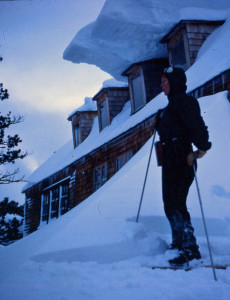 I, Verna West, have chosen to include some names in this document, most of which were very early members and continued their support of the California Alpine Club for the rest of their lives. Some of them have members of their families still living and active in the Club, such as myself and my children and grandchildren. For every name mentioned herein, there were dozens (sometimes hundreds) of people working alongside or in the background.
I, Verna West, have chosen to include some names in this document, most of which were very early members and continued their support of the California Alpine Club for the rest of their lives. Some of them have members of their families still living and active in the Club, such as myself and my children and grandchildren. For every name mentioned herein, there were dozens (sometimes hundreds) of people working alongside or in the background.
There is an on-going effort to catalog the California Alpine Club archive. Please feel free to submit additional materials for archival consideration to any Board member. TRAILS newsletters from 2006 to date, as well as other Club business documents, can be found in the Club Business Archives section of this website.
–Verna West
March 2012
CAC Member since 1952
AUTHOR’S NOTE
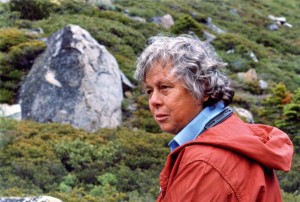 My husband’s father, Harry Phillip West, was a member of the YMCA youth group in 1912 and became a member of the first California Alpine Club Board of Directors in 1915. His mother, Anita Franz, joined the Club in March 1917 and served as Secretary in 1919. They both kept albums of photographs—hers were mostly labeled, his not. Some of those earliest members were life-long West-family friends and there were many photos taken over the years. I came to California from Wyoming in 1950, joined CAC in 1952, married Harry W. West in 1953, and was more active at Echo Summit Lodge than the Alpine Lodge until recent years. I also have taken many photos that are labeled in chronological order and mounted in albums at my home.
My husband’s father, Harry Phillip West, was a member of the YMCA youth group in 1912 and became a member of the first California Alpine Club Board of Directors in 1915. His mother, Anita Franz, joined the Club in March 1917 and served as Secretary in 1919. They both kept albums of photographs—hers were mostly labeled, his not. Some of those earliest members were life-long West-family friends and there were many photos taken over the years. I came to California from Wyoming in 1950, joined CAC in 1952, married Harry W. West in 1953, and was more active at Echo Summit Lodge than the Alpine Lodge until recent years. I also have taken many photos that are labeled in chronological order and mounted in albums at my home.
Verna Steele West
Menlo Park, CA
March 12, 2012
Sources of Information:
• 1914-1919: Club Meeting Minutes from the Archives in the Tam Building
• CAC 1920 TRAILS, page 1, “California Alpine Club” by Norma Holroyd Pinther
• Caroline Waldear joined in the fall of 1916. In 1982-1983, encouraged by Win Hayward and Margaret Dormeyer, she asked for stories, biographies, and memories, from many early members. Caroline edited and rewrote some of the submissions (making some errors) and wrote stories of her own. Included in the resulting “CAC History” published in 1983 are old photos, including some from the West family. The booklet was “xeroxed,” resulting in poor quality photos, but the stories are wonderful. There are copies in binders at Alpine Lodge.
• Copies of TRAILS, Reunion Programs, and other written material in West family files.
• Muriel Less’ brief “CAC History” article, Alpine Lodge Hostess Manual 2003.
